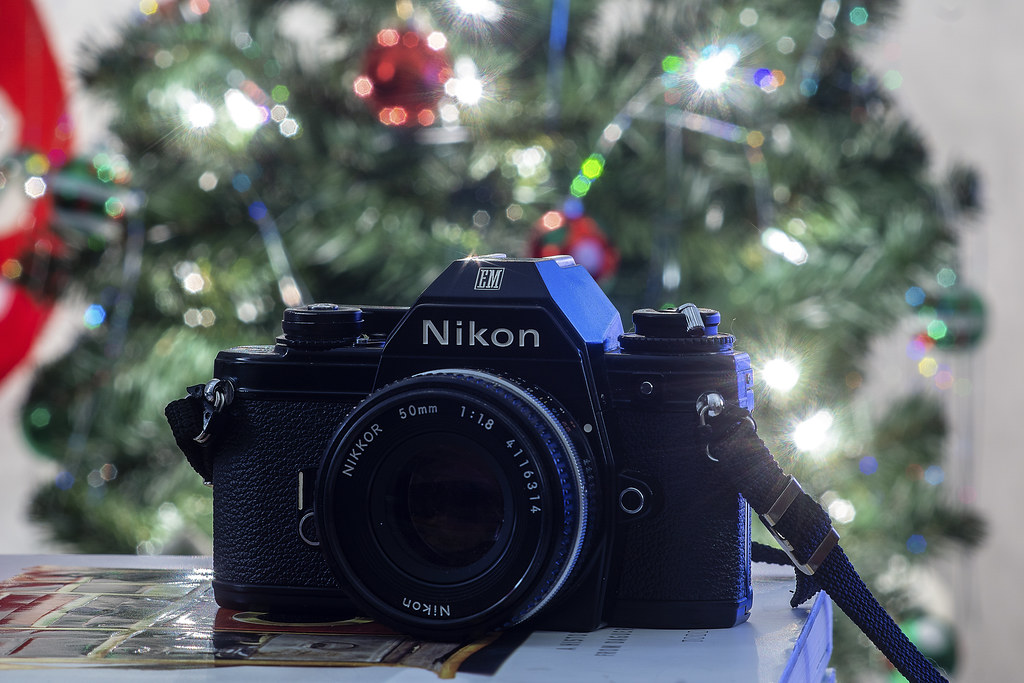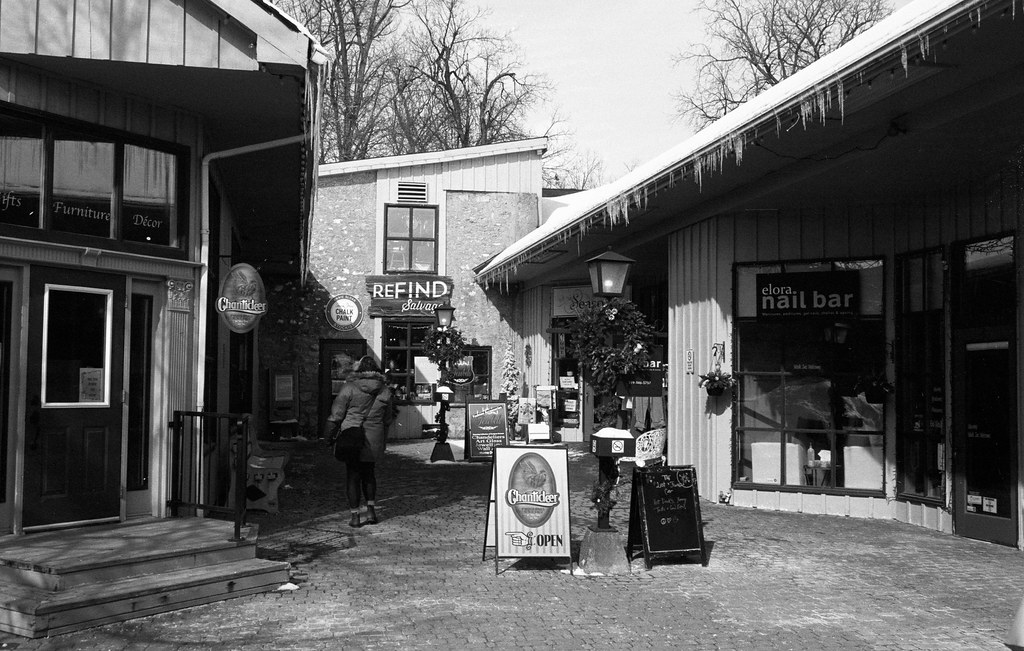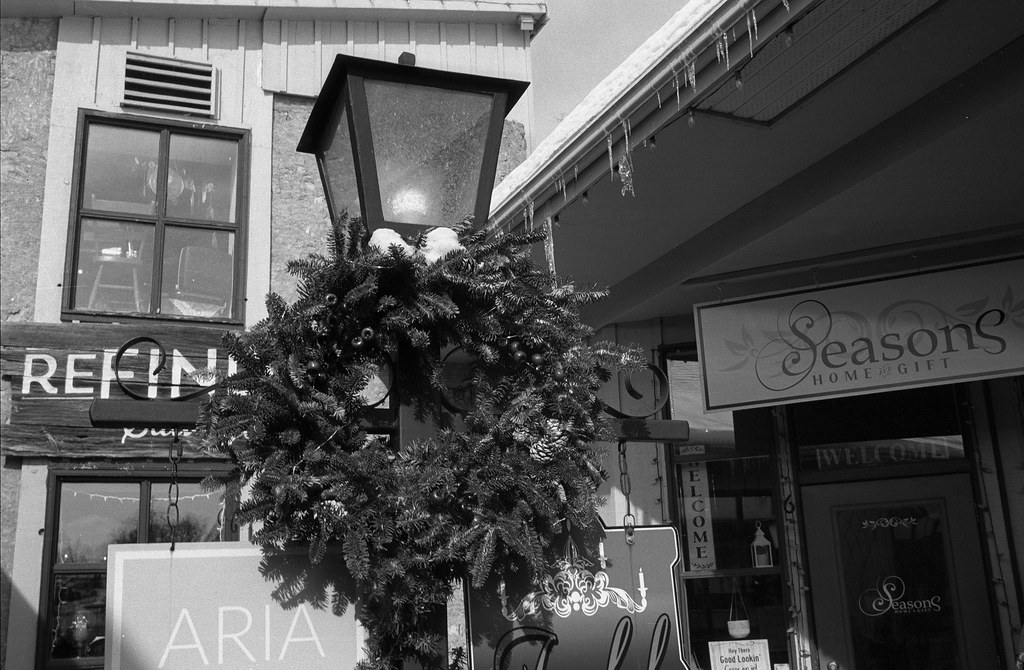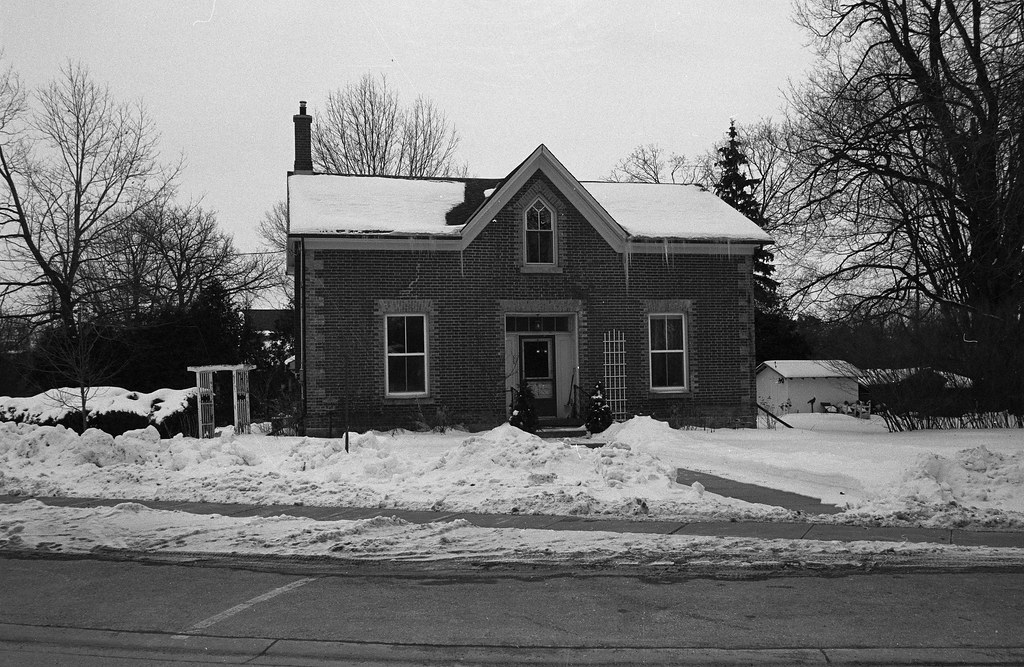If you’ve ever seen the TV show Madmen, you’ll probably have your 21st Century, post MeToo era sensibilities challenged with the sheer amount of sexism that was and is still rampant today. Now if you’re a little confused, let me introduce you to the Nikon EM. Designed to fill in the entry-level gap in the Nikon SLR line, the EM was primarily marketed towards women. The reason is that as a camera, it is basic, set for semi-automatic aperture priority, and that is the only mode available. It also is small, compact, and lightweight. But don’t let that stop you, the EM is an excellent camera to have in your Nikon stable if you need something no-nonsense will perform correctly with any Nikon F-Mount lens (AI and AI-S). It’s a camera meant to be shot without too much thought towards your exposure and looking for something that can tuck in any camera bag or non-camera bag without little addition towards overall weight.

Camera Specifications
Make: Nikon
Model: EM
Type: Single Lens Reflex
Format: 135 (35mm), 36x24mm
Lens: Interchangeable, Nikon F-Mount
Shutter: Electronic Metal Vertical Focal Plane Shutter, 1″ – 1/1000″ + 1/90 (Mech.) + Blub
Meter: TTL Centre-Weighted SPD Cell, EV2 – EV18, ASA-25-ASA-1600
Year of Manufacture: 1979-1982, available as new until 1984


Background
Nikon has always had a strange relationship with their consumer and entry-level market. Not for lack of trying. They attempted a crack at it with the Nikkorex 35 and 35|2 which both failed due to a lack of quality control that many associated with Nikon. The Nikkormat line found a following with the advanced amateur market, but the cameras were big, heavy, and all metal. The electronic semi-automatic Nikkormat EL released in 1972, introduced the idea of an electronic camera into the Nikon lineup. And it’s the EL and EL2 that we can trace as the foundation of the EM. But as many students of Nikon history knows, the EL2 would become the Nikon FE in 1978. And Nikon again decided to crack into the consumer market. But Canon’s release of the AE-1 introduced another new idea, the idea of a plastic camera. Like Canon’s F-1 was Canon’s answer to the Nikon F2, the Nikon EM was Nikon’s answer the AE-1. But the EM would be a direct departure from the Nikon ethos of uncompromised design and robust cameras. To help them along the way they brought in noted Italian industrial designer Giorgetto Giugiaro to design the camera. The EM replaced the hard lines and angles of the past with a sleek and stylish package. The EM is a work of art and would earn Giugiaro a place in Nikon history, but not for 1979’s EM, but for 1981’s Nikon F3. But that was not only where the EM departed what had been the standard; the EM would have only a single mode, Aperture Priority, along with a 1/90″ mechanical backup and bulb, it would also only come in black. The exposure system is driven by the standard 60/40 centre-weighted TTL meter. At least Nikon kept their F-Mount that worked with any AI or AI-S lens, but to distance the EM from their professional offerings further, they created a line of AI-S compliant lenses but marked them “Series E” rather than Nikkor. A two frames-per-second motor drive, the MD-E would also be designed to work with the EM. The camera was so far distanced from the Nikon pro offerings, the marketing department also took a strange turn and decided to market the EM directly to women because of the simplicity of operation. A sexist move by today’s standards. And yet the EM saw a reasonable amount of success in the days where small-form factory SLRs were gaining a market. Manufacture of the EM ended in 1982, replaced by the Nikon FG. But in a strange twist, the EM continued to sell new on the shelf for the entire production life of the FG. The EM pulled from shelves in 1984 when the FG was discontinued.


Impressions
The first thing you notice about the EM is how small the camera is compared to the cameras that preceded the release of the EM; the second is the black plastic construction. You can see that a proper designer came on board for this camera. You can even go so far as to say that the EM set a precedent for the small-format SLRs that Nikon produced afterwards, you can see elements of the EM in the FG, FA, and FG-20. And yes, even the F3 took some of its design cues from the EM and no surprise as Giugiaro worked on both those cameras. The camera controls are the absolute basic. You have your three-position switch were you select auto (aperture priority), M90, and bulb. And here lies one of my biggest functional deficiencies in the EM, the lack of a dedicated on/off switch. To turn the camera ‘off’, you set the camera to either M90 or Bulb. I had the same complaint about the Nikon FG, at least with the EM it’s much easier to turn on and off. One nice touch is the battery check button on the top plate. The film advance is a plastic piece attached to the actual advance leaver; it seems a little flimsy in my books and with just the right amount of force might break. At least some parts of the camera are metal, such as the film rewind and the lens mount. And having that metal F-Mount on the front makes the EM a little easier to swallow. And despite the small the size, the camera is an easy choice when you want to shoot your Nikon lenses, but want a no-nonsense camera that doesn’t add too much extra weight. And you know, it feels good in the hand, even with my mitts that like a larger grip. And sure the MD-E would add that extra grip, which would certainly help.


Experiences
If you’re used to the small format Nikon, get ready for something even smaller and lighter than your average FE. The EM is about a centimetre narrower along the bottom and a millimetre narrower on the width. Despite being a touch smaller, it presents a good feel in hand. Although I think a finger grip like what was added to the FG/FA moulded into the body would certainly help with the ergonomics. But the MD-E might help with that even; sadly, I don’t have one. Loading the film is just like another Nikon of the era, you lack the safety catch on the film door release. Having that manual 1/90″ certainly helps when you advance the film up to one on the counter. The camera feels a lot like a compact version of the Nikon FE, right down to the viewfinder and the twin-needle meter readout. While not as bright as the viewfinder in the FE, the EM does a good job when you have good light. But as the day went on and the skies dimmed it certainly showed in the viewfinder. The shutter has a decent click when depressed, and the film advance stroke isn’t too far. I just always feared that the leaver would break off the actual mount the whole time. I can certainly see the draw of the EM, the lightweight body can be carried for hours without adding any extra weight and a Series E lens would have made it even better. But shooting in Elora, I wanted something a little wider and went with a heavier AI-S Nikkor 35mm f/2.8 lens. Rewinding the film went without a hitch, but I also felt like the rewind knob was going to fly off or break the shaft.


Optics
I could talk to no end about the power of Nikon glass. But you can look any other review I’ve written on a manual focus Nikon camera to listen to my extol their virtues, let me instead turn towards the line of lenses that Nikon designed for the EM. Like the ME (Super) and the SMC Pentax-M lenses, Nikon produced the Series E glass. While the glass doesn’t say Nikkor and doesn’t look like your traditional Nikon lenses, these lenses are made to the same standards as Nikkor glass but don’t have the same metal bodies. The lens bodies are mostly plastic and lack the ‘claw’ used to connect to older Nikon bodies. The lenses themselves are AI lenses, which means you can use them on Nikon SLRs that support AI(-s) lenses. But you can use any of Nikkor glass on the EM, but to keep the camera done in overall size and weight the Series E lenses are the best choices. The 28/2.8, 50/1.8, and even the 70-210mm are excellent choices for your EM kit.


Lowdown
When I first got into this review, I didn’t think I would end up recommending the EM. And while one of the reviews I found on the EM is titled “Pro on the Outside, Carefree on the Inside” I think the reviewer got those two reversed, the EM is a Carefree, simple camera on the outside but has the professional soul that is typical of Nikon cameras. And while the EM is not the camera for everyone, if you want a little more of a challenge in your life, then certainly avoid the EM. But if you want something to soothe your complex soul, then an EM might fit the bill. If you are looking to pick one up, get one that is in the 50-100$ range on the used market, and preferably one that is tested and known to work. And herein lies my warning, the EM is not the most reliable camera, after shooting the roll for a review the camera up and died on me. But you’re dealing with early 1980s electronics and a camera that wasn’t built to the same exacting standards that Nikon put into their other bodies. And at the low cost of the bodies, it’s easier to replace rather than repair. But to be honest and all the faults of the EM and its marketing angle, the EM is the perfect camera for the beginner, intermediate, and advanced photographers. Because in the end, it’s about the person behind the camera, then the camera itself.


Further Reading
Don’t just take my word on the Nikon EM, you can check out the reviews by other awesome camera reviewers!
The Nikonians – Nikon EM Review
35mmc – Nikon EM: The SLR for Women
Casual Photophile – Trying to Care about Photography, A Nikon EM Review
Mike Eckman Dot Com – Nikon EM Review
Camera Legend – Nikon EM Review
Lomography – Nikon EM Pro on the Outside, Carefree on the Inside
Camera Go Camera – Nikon EM Review
1 Comment